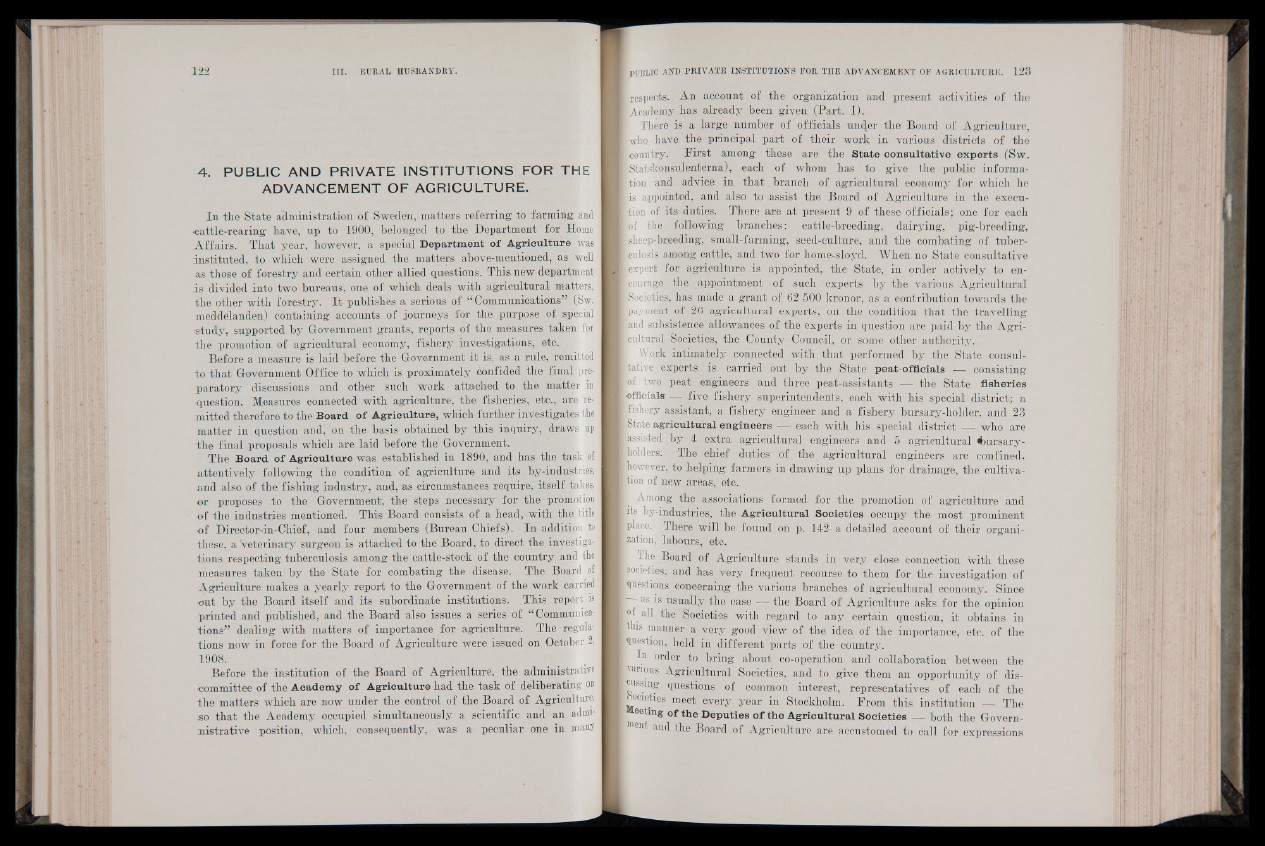
4. PUBLIC AND PRIVATE INSTITUTIONS FOR THE
ADVANCEMENT OF AGRICULTURE.
In the State administration of Sweden, matters referring to farming and
■cattle-rearing have, up to 1900, belonged to the Department for Home
Affairs. That year, however, a special Department o f Agriculture was
instituted, to which were assigned the matters above-mentioned, as well
as those of forestry and certain other allied questions. This new department
is divided into two bureaus, one of which deals with agricultural matters,
the other with forestry. It publishes a serious of “ Communications” (Sw.
meddelanden) containing accounts of journeys for the purpose of special
study, supported by Government grants, reports of the measures taken for
the promotion of agricultural economy, fishery investigations, etc.
Before a measure is laid before the Government it is, as a rule, remitted
to that Government Office to which is proximately confided the final preparatory
discussions and other such work attached to the matter in
-question. Measures connected with agriculture, the fisheries, etc., are remitted
therefore to the Board o f Agriculture, which further investigates the
matter in question and, on the basis obtained by this inquiry, draws up
the final proposals which are laid before the Government.-
The Board o f Agriculture was established in 1890, and has the task of
attentively following the condition of agriculture and its by-industries,
-and also of the fishing industry, and, as circumstances require, itself takes,
or proposes to the Government, the steps necessary for the promotion
o f the industries mentioned. This Board consists of a head, with the title
o f Director-in-Chief, and four members (Bureau Chiefs). In addition to
these, a veterinary surgeon is attached to the Board, to direct the investigations
respecting tuberculosis among the cattle-stock of the country and the
measures taken by the State for combating the disease. The Board of
Agriculture makes a yearly report to the Government of the work carried
out by the Board itself and its subordinate institutions. This report is
printed and published, and the Board also issues a .series of “Communications”
dealing with matters of importance for agriculture. The regulations
now in force for the Board of Agriculture were issued on October %'
1908.
Before the institution of the Board of Agriculture, the administrative
committee of the Academy o f Agriculture had the task of deliberating on
the matters which are now under the control of the Board of Agriculture,
so that the Academy occupied simultaneously a scientific and an administrative
position, which, consequently, was a peculiar one in many
I respects. An account of the organization and present activities of the
I Academy has already been given (Part. I),
There is a large number of officials unc|er the Board of Agriculture,
[ who I have the principal part of their work in various districts of the
[country. First among these are the State consultative exp e r ts. (Sw.
jStatskonsulenterna), each of whom has to give the public informa-
[tion and advice in that branch of agricultural economy for which he
[is appointed, and also to assist the Board of Agriculture in the execu-
[tion of, its duties. There are at present 9 of these officials; one for each
[of the following branches: cattle-breeding, dairying, pig-breeding,
[sheep-breeding, 'small-farming, seed-culture, and the combating of tuber-
[culosis among cattle, and two for home-sloyd. When no State consultative
[expert (for agriculture is appointed, the State, in order actively to en-
tcourage the appointment of such 'experts by the various Agricultural
[Societies, has made a grant of 62 500 kronor, as a contribution towards the
: payment of 26 agricultural experts, on the. condition that the travelling
land subsistence allowances of the experts in question are paid by the Agri-
fcultural Societies, the County Council, or some other authority.
Work intimately connected with that performed by the State consultative
experts is carried out by the State peat-offieials — consisting
of two peat engineers and three peat-assistants the State fisheries
officials — five fishery superintendents, each with his special district; a
fishery assistant, a fishery engineer and a fishery bursary-holder, and 23
| State agricultural engineers — each with his special district who are
[assisted by 4 extr.a agricultural engineers and 5 agricultural #mrsary-
j holders. The chief duties of the agricultural engineers are confined,
however, to helping farmers in drawing up plans for drainage, the cultiva-
[tion of new areas, etc.
| Among the associations formed for the promotion o f , agriculture and
| its by-industries, the Agricultural Societies occupy the most prominent
.place. There will be found oh p. 142- a detailed account of their organisation,
labours, etc.
The Board of Agriculture stands in very close connection with these
[societies, and has very frequent recourse to them for the investigation of
(questions concerning the various branches of agricultural economy. Since
| as is usually the case |p: the Board of Agriculture asks for the opinion
Inf all the Societies with regard to any certain question, it obtains in
p is manner a very good view of the idea of the-importance, etc. of the
^question, held in different parts of the country.
t In order to bring about co-operation and collaboration between the
parious Agricultural Societies, and to give them an opportunity of disu
s in g questions of common interest, representatives of each of the
ocieties meet every year in Stockholm. From this institution — The
eeting o f the Deputies o f the Agricultural So cieties — both the Govern-
and the Board of Agriculture are accustomed to call for expressions